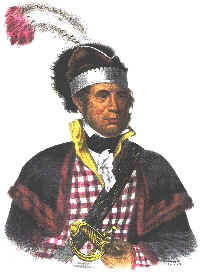|
|
 |
 |
 |
 |
 |
 |
|
|
The Five Civilized Tribes
|
 |
 |
 |
 |
|
|
|
The "Five Civilized Tribes"
The lands which the Osage and Quapaw had ceded to the United States government were turned over to the Indians of the old Southeast, who were being relocated from their tribal homes. Five tribes of these Indians had come to be known as the Five Civilized Tribes because of their advanced systems of government, education and law enforcement.
These tribes were the Choctaw, Chickasaw, Cherokee, Creek and Seminole. The most peaceful removal among the Five Civilized Tribes was the Choctaw in 1820. The other four tribes followed, with removals becoming increasingly bloodier from internal skirmishes and bouts with white men.
MUSCOGEE (Creek)

William McIntosh
In early historic times, most of the area now known as Georgia was occupied by Indians belonging to the Creek Confederacy. The largest group in this alliance was composed of people of the Muskogean linquistic group which included the Muscogee, Hitchiti and Yamassee. Central to Creek government was the talwa, or town, consisting of a ceremonial and political center with all outlying villages and settlements. Towns were strung out along the rivers of their territory. Their economy was based on a combination of agriculture, hunting and gathering. With the beginning of European contact and trade, Creek lifeways began to change dramatically. For years, they served as a buffer between the English colonies at Charleston and Savannah and Spanish-dominated Florida. After the American Revolution, many Creeks became prosperous farmers; others followed a more traditional way of life. The state of Georgia gradually pushed the Creeks westward. In 1826, Creek leader William McIntosh signed a treaty ceding the last Creek lands in Georgia in return for land in what would become Oklahoma.
CHEROKEE

Sequoyah
Though most of their territory lay in the Apalachian highlands of east Tennessee and western North Carolina, the Cherokee possessed much of North Georgia during the early historic period. Their language belongs to the Iroquois linquistic family, but their culture was closely related to other Southeastern tribes. They lived in permanent villages near broad river bottoms suitable for agriculture. They were a single tribe composed of seven clans. Their capitol changed from town to town depending upon the residence of the principal chief. After the American Revolution, they adopted a new course patterned after the newly formed United States government. Development of a syllabary by Sequoyah allowed the Cherokee to publish books and newspapers in their own language. Many became wealthy. Despite their accomplishments, their land was coveted by a tide of white settlers and they were forced to relocate to Oklahoma (The Trail of Tears). A few managed to hide out in the mountains where they were eventually granted a reservation in the vicinity of what is now Cherokee, North Carolina.
CHICKASAW
Chickasaw territory centered on their "old fields" near Tupelo, Mississippi; however, they contoled a huge region bounded by the Ohio, Mississippi, Tennessee and Tombigbee Rivers. One outlying town was located near Augusta, Georgia. Their tribe was a matrilineal society divided into clans and ruled by the "High Minko," known to Europeans as the King of the Chickasaws. This ruler was assisted by a national advisory council. The Chickasaws had contact with the French in the Mississippi River valley, but established firm trading ties in the late 1600's with English traders from South Carolina. They gained renown as the fiercest fighters of the south and were almost constantly engaged in conflicts with the Chocktaws, Creeks, Cherokee, and even the Shawnee and Iroquois to the north. The Chickasaws also battled with French traders on the Mississippi River. They began their westward emigration in 1822, and by 1834, they were gone from the old South. The tribe located in what is now Oklahoma.
CHOCTAW
Tribal legends say this group originated at Nanih Waiya Mound in east-central Mississippi. Historically, they centered on this area reaching east into the Tombigbee River lands of Alabama, along the boundary of the Creeks. Their villages formed the basis of three great districts, each ruled by a chief, which together constituted the Choctaw Nation. Like other southeastern Indians, their society was based on matrilineal clans. They celebrated the busk (Green Corn Ceremony) and held large ball games. They were the most intensive farmers of the south and were noted for their peaceful character and friendly disposition. Due to the nearby French settlements and trading posts along the lower Mississippi River, the Choctaw were influenced by them and were in one band of Choctaws managed to remain in their homeland, despite tremendous opposition and hardship. This group currently lives on a reservation near Philadelphia, Mississippi.
SEMINOLE

Osceola |
|
|
|
|
|
 Native American Nations
Native American Nations
